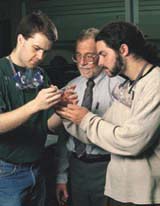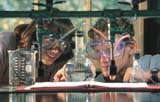

"In some ways team teaching is humbling, because you realize how well it can be done. It motivates you not to accept an average effort, but to really put yourself out there and try to think very creatively about the teaching process."


Magazine
Fall 1998
"Leave Your Ego at the Door"
Team teaching in the Wabash chemistry department results in
a rich combination of wisdom, enthusiasm, creativity, inspiration, and a
touch of humility.
It's early on a Friday afternoon in the basement of Goodrich Hall and first-year Assistant Professor of Chemistry Ann Taylor has stopped by department chair Rich Dallinger's office to pick up a packet of papers.
"We were talking yesterday about an experiment I taught in a bio-analytical course and she said she'd like to see it," Dallinger says. "It's inevitable that, when you teach the same courses, you're going to want to talk to each other about them, ask questions, ask if they've ever run across a really good experiment."
This sort of exchange occurs daily in the Wabash chemistry department, whose unique team-teaching approach to the courses taught in the first two years of its curriculum enhances teaching and learning for both students and professors. The department teams senior and junior faculty up in teaching of the introductory courses that are often the domain of teaching assistants at large universities. The result is a rich combination of wisdom, enthusiasm, inspiration, and teaching improvisation that turns out uncommonly accomplished majors while passing on solid knowledge and appreciation of the discipline to non-majors.
Dallinger says the team approach has been a part of the department for as long as he can remember, and he discussed its benefits--and challenges:
Dallinger: Team-teaching is not just dividing up a course and saying "you do this part, and I'll do this part." Team-teaching is working as a team of faculty to try to implement new teaching strategies, to figure out together ways to present new or difficult material. Different people bring different ideas to the team.
For example, this semester Chem 3 is being taught by David Phillips and our two new faculty, Scott Feller and Ann Taylor. Not only does it allow the new folks to learn from an experienced faculty member about our general chemistry course and how we teach, but it also allows them to bring their ideas to the course. New people are not apprentices-they're partners. They are learning and they're contributing too.
WM: Any examples of new ideas that have moved through the whole department because of these partnerships?
Dallinger: John Zimmerman has been working for several years on utilitizing technology in the classroom. He's developing technique videos which we use in our quantitative, general, and advanced courses. This is spreading throughout the department. He comes up with this idea of how to use video in the classoom, and all of a sudden you see it popping up in all sorts of courses. That's because we work together and see how its done.
During his last sabbatical, David Phillips was at the University of Wisconsin, learning about their strategies on how to use less lecture and more recitation, how to use more group, student-on-student learning experiences. As a result, he has helped to change the way we teach general chemistry. We have fewer lectures and more recitations, problem-solving exercises and groups of students working on a problem. It takes a lot of person power to teach a course that way-it takes less to lecture-but we feel this is a much more effective way.
WM: What do you find to be the personal advantages of the team-teaching approach?
Dallinger: Teaching is a relatively solitary experience. You don't think of it that way, because you're always in front of students. But as a professional trying to figure out the most effective way to get the grand ideas of your discipline across, it can be a fairly solitary process. Team teaching helps you get out of that. It puts you in contact with your colleagues in a very specific working situation. You have that focused process where all of you try to figure out how to teach these ideas well. You also have the opportunity to observe and be motivated, challenged, and stimulated by teaching with some really good people. John Zimmerman, Paul McKinney, David Phillips, Bob Olsen-these are stunningly good teachers. In fact, in some ways team teaching is humbling, because you realize how well it can be done. It motivates you not to accept an average effort, but to really put yourself out there and try to think very creatively about the teaching process.
WM: Team-teaching has to have a down side.
Dallinger: Well, you have to leave your ego at the door a little bit. It's scarier to teach in front of your colleagues than it is in front of students, and you have to be willing to accept constructive criticism and suggestions. You have to be willing to think about different ways to do things. It's not the simplest thing, but everybody in the department is doing it-it becomes the norm, and the positive things you take away make it well worth it when you're really interested in teaching.
It's also a wonderful way to see new people in action-to receive some of their excitement and their ideas. It's not initially meant to be an evaluative process, but in a situation where a department does have to evaluate junior faculty, for us it's pretty simple. We teach with them as partners. Add to that the student response to what they do and you get an extraordinarily clear picture of your colleagues as teachers.
WM: Does all of this enthusiasm carry over to the students?
Dallinger: I think the excellence of teaching affects them greatly, and I think they like being exposed to the different faculty in their early years. They see folks like McKinney and Zimmerman, who work so well together in Chem 1, and I think students are energized by that as well.
Science is a community activity, and watching excellent teachers work together helps to reinforce that idea.
